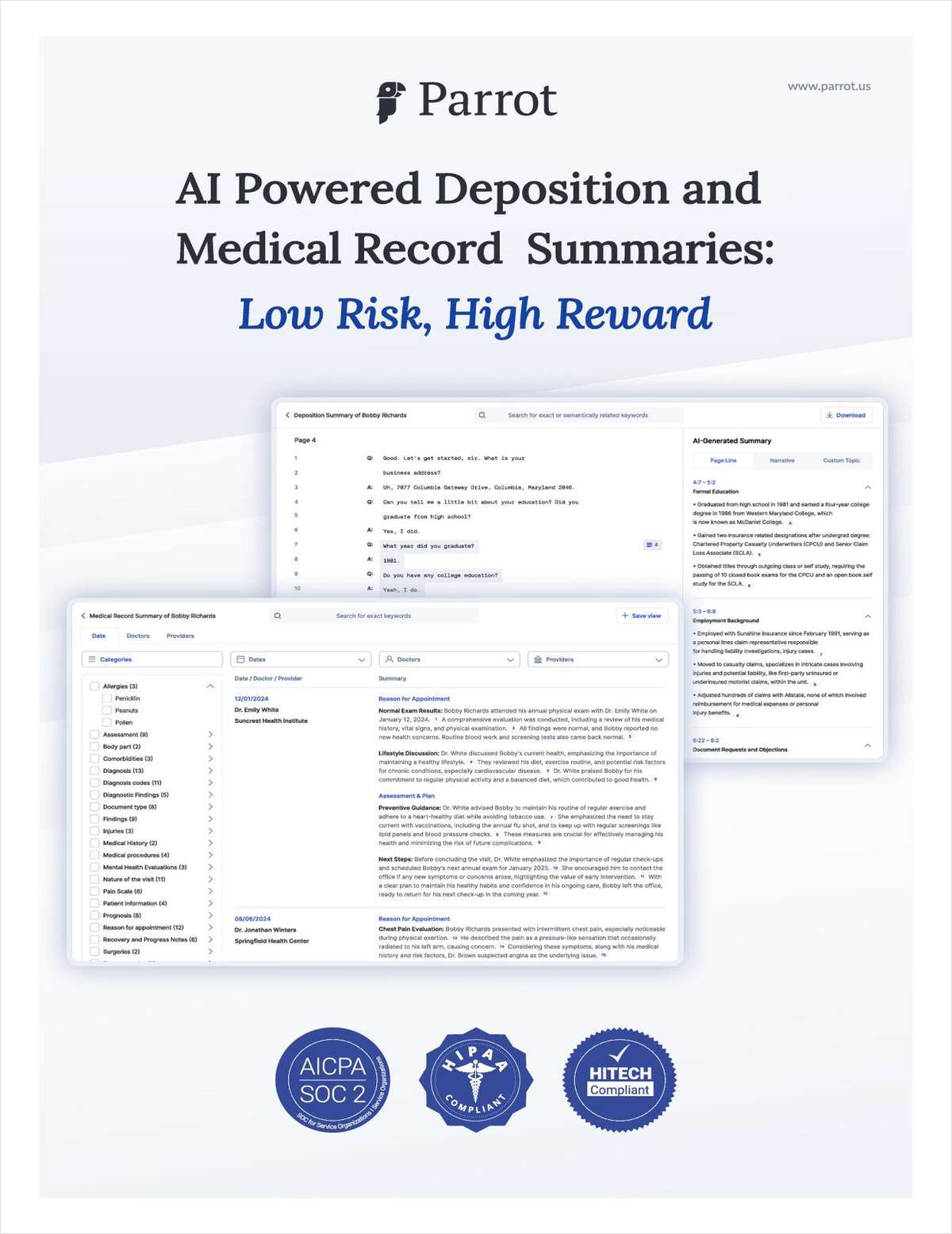More Than Just a Name Change: 'Everything is on the Table' When a Law Firm Rebrands
"The threshold question is, what are people already calling you? The reality is, your marketplace is already calling you this. Let's agree with them. Let's simply reflect the marketplace."
December 14, 2018 at 09:46 AM
8 minute read
 Si Griffiths, via Wikimedia Commons
Si Griffiths, via Wikimedia Commons
Editor's Note: This story is adapted from ALM's Mid-Market Report. For more business of law coverage exclusively geared toward midsize firms, sign up for a free trial subscription to ALM's new weekly newsletter, The Mid-Market Report.
Rebranding at Swift, Currie, McGhee & Hiers might appear to have been a simple proposition—yielding a new logo—but the process, just recently completed, took a year.
A variety of voices, vendor hires, potentially wounded egos, and a lot of time—all of those are elements in the rebranding formula. At no two firms is the process identical. But several commonalities tie them together: the process must be deliberate, and the firm must emerge with a clear message.
Swift Currie, a 145-lawyer litigation firm based in Atlanta, last changed its logo 15 years ago, when the firm unveiled a logo that dropped “McGhee & Hiers” from its public image (though not its formal name.) The logo unveiled in September 2018 is far different, with the two names marked in lower-case cursive, divided by a gold slash. It will be on everything with the firm name—from business cards to golf shirts.
The change was developed by two outside companies and a firmwide committee of about 20 people, said managing partner Terry Brantley and business development director Michele Golivesky.
“We got our share” of initial concerns, Brantley said, noting that many lawyers tend to disagree with any form of change.
“It's a new look, but the same client service,” Golivesky, who was marketing director during the 2003 rebrand, said.
She and Brantley said the change was based in part on interviews with clients, outside lawyers, and lawyers and staff within the firm, which has doubled in size since the 2003 rebranding effort. The interviews, they explained, revealed that the firm was known for lawyers who were approachable, with whom clients can talk about anything.
The firm created “connections beyond 'just a client,'” said Brantley, hence the informal look of the logo.
For Norris McLaughlin—Norris, McLaughlin & Marcus until earlier this year—rebranding seems not to have been a cumbersome process, but due diligence was necessary.
“While we didn't need a consultant for the name change, we did hire a design firm to guide us with such things as our new color scheme, logo design, etc.,” said John Vanarthos, managing partner of the Bridgewater, New Jersey-based midsize firm, in an email. Clients were not asked for input up front, but have given positive feedback since the rebranding launched earlier this year, he noted.
“The process of changing the name was to follow the industry trend of shortening names,” Vanarthos said, noting that firm leaders originally wanted to go with “Norris Law,” but “found it was too common in the marketplace, [and] as such there was very limited availability for website/domain names, etc.”
When it comes to rebranding, ”Everything is on the table,” said Ross Fishman of Chicago-based Fishman Marketing, who works with law firms. “They look at all of the elements. These include the message to the marketplace.”
The mindset for launching a rebrand, according to Fishman, ranges from “time for a new logo” to “time for an entirely new message.”
Norris McLaughlin's Vanarthos said most law firms “are referred to by the first and/or first and second names of the firm name, and since we're already commonly called Norris McLaughlin, it was easy to make that decision in one management committee meeting.”
According to Fishman, that's the right line of thinking.
“The threshold question is, what are people already calling you?” Fishman said. “The reality is, your marketplace is already calling you this. Let's agree with them. Let's simply reflect the marketplace.”
Two names, or even one name, usually suffices to identify a law firm in conversation—perhaps three names in a rare case, Fishman said, noting Am Law 200 firm Frost Brown Todd. And thus only those few names belong on the firm's logo, he said.
Fishman also pointed to his work with New Orleans-based midsize firm Galloway, Johnson, Tompkins, Burr & Smith, whose website and logo were reworked to emphasize the “Galloway” name.
The first part of the process—the “intake,” as Fishman called it—involves hour-long interviews with partners or major stakeholders, rather than group meetings, in which people are rarely candid, he said. Often midsize and smaller firms “have a style they can't even quite define themselves,” but they have a strong sense of the firm's tradition and identity, so these interviews go a long way to driving the rebrand, Fishman said.
Drafting visuals and graphics can take a few weeks, but the entire creative process can be done in a month's time, he said.
The creative part of the process need not be drawn out. But at Galloway Johnson—whose logo and brand previously featured an acronym of the name partners, “GJTBS”—getting buy-in from those name partners was a considerable part of the process, according to firm managing partner Jason Waguespack.
The idea and creative concept to rebrand came largely from firm partner Timothy Hassinger, and was raised at partner meetings. But the idea didn't get an especially warm reception from the name partners—of whom most were nearing retirement, while one was already deceased.
“When the concept was first brought up, I think all of them had a cautious if not negative reaction to it,” Waguespack said. But after a meeting with those partners and Fishman, who made a presentation and explained the rebranding objective, as well as the importance of brevity and clarity, they assented to the change, which the other partners readily approved by vote, according to Waguespack.
“The most important thing was stressing that we were not changing the firm's name, that the only thing we were really changing was our brand,” Waguespack said.
Names on a law firm logo can be a touchy issue, sure, but then there's the matter of the ampersand.
In eras past, “lawyers loved their ampersands with a fiery passion,” Fishman said. “No one outside of law even knows what an ampersand is.”
The beloved ampersand was a casualty of the 2018 rebranding at Hartford, Connecticut-based Halloran Sage, the Connecticut Law Tribune, a Mid-Market Report affiliate, reported earlier this year.
“It was a very deliberate process,” Chief Operating Officer David Urbanik said in the report. “The rebranding happened last month, but the process leading up to it was a year-and-a-half long.”
That process resulted in a new website, along with a short-format video.
“We took time to survey our employees and survey our clients,” Urbanik said. “We spent time sharing ideas internally to be sure what we thought were the values and what was driving us was shared universally—literally everyone in the firm shared in that process. We wanted to make sure that the brand really reflected who we are.”
A sense of who the clients are, not just who the lawyers are, is an equally vital part of the process, it seems.
Hirschler Fleischer, an 80-lawyer firm based in Virginia, recently rebranded in order to make the name more memorable in the Northern Virginia market, into which the firm expanded in 2016. But the question of name recognition spurred a more intensive exploration into how the firm viewed itself and how people outside viewed it, according to Courtney Paulk, president of the firm's board of directors.
Paulk said the key revelation was that while lawyers in the firm saw themselves as litigators or transactional lawyers, “clients don't see us that way.” Instead, she said, clients were more interested in what lawyers knew about their respective industries.
The effort eventually led the firm to hire outside vendors to redevelop the firm's website from “just looking good” to telling the firm's story about how well it knows its clients and their businesses.
Paulk said firms contemplating a rebrand should go through a period of introspection and then choose their vendors carefully.
“Clients want to know you understand that industry,” she said.
Jonathan Ringel and Michael Marciano contributed to this report.
This content has been archived. It is available through our partners, LexisNexis® and Bloomberg Law.
To view this content, please continue to their sites.
Not a Lexis Subscriber?
Subscribe Now
Not a Bloomberg Law Subscriber?
Subscribe Now
NOT FOR REPRINT
© 2025 ALM Global, LLC, All Rights Reserved. Request academic re-use from www.copyright.com. All other uses, submit a request to [email protected]. For more information visit Asset & Logo Licensing.
You Might Like
View All
Law Firms Look to Gen Z for AI Skills, as 'Data Becomes the Oil of Legal'


'A Warning Shot to Board Rooms': DOJ Decision to Fight $14B Tech Merger May Be Bad Omen for Industry

'Incredibly Complicated'? Antitrust Litigators Identify Pros and Cons of Proposed One Agency Act
5 minute readTrending Stories
- 1Uber Files RICO Suit Against Plaintiff-Side Firms Alleging Fraudulent Injury Claims
- 2The Law Firm Disrupted: Scrutinizing the Elephant More Than the Mouse
- 3Inherent Diminished Value Damages Unavailable to 3rd-Party Claimants, Court Says
- 4Pa. Defense Firm Sued by Client Over Ex-Eagles Player's $43.5M Med Mal Win
- 5Losses Mount at Morris Manning, but Departing Ex-Chair Stays Bullish About His Old Firm's Future
Who Got The Work
J. Brugh Lower of Gibbons has entered an appearance for industrial equipment supplier Devco Corporation in a pending trademark infringement lawsuit. The suit, accusing the defendant of selling knock-off Graco products, was filed Dec. 18 in New Jersey District Court by Rivkin Radler on behalf of Graco Inc. and Graco Minnesota. The case, assigned to U.S. District Judge Zahid N. Quraishi, is 3:24-cv-11294, Graco Inc. et al v. Devco Corporation.
Who Got The Work
Rebecca Maller-Stein and Kent A. Yalowitz of Arnold & Porter Kaye Scholer have entered their appearances for Hanaco Venture Capital and its executives, Lior Prosor and David Frankel, in a pending securities lawsuit. The action, filed on Dec. 24 in New York Southern District Court by Zell, Aron & Co. on behalf of Goldeneye Advisors, accuses the defendants of negligently and fraudulently managing the plaintiff's $1 million investment. The case, assigned to U.S. District Judge Vernon S. Broderick, is 1:24-cv-09918, Goldeneye Advisors, LLC v. Hanaco Venture Capital, Ltd. et al.
Who Got The Work
Attorneys from A&O Shearman has stepped in as defense counsel for Toronto-Dominion Bank and other defendants in a pending securities class action. The suit, filed Dec. 11 in New York Southern District Court by Bleichmar Fonti & Auld, accuses the defendants of concealing the bank's 'pervasive' deficiencies in regards to its compliance with the Bank Secrecy Act and the quality of its anti-money laundering controls. The case, assigned to U.S. District Judge Arun Subramanian, is 1:24-cv-09445, Gonzalez v. The Toronto-Dominion Bank et al.
Who Got The Work
Crown Castle International, a Pennsylvania company providing shared communications infrastructure, has turned to Luke D. Wolf of Gordon Rees Scully Mansukhani to fend off a pending breach-of-contract lawsuit. The court action, filed Nov. 25 in Michigan Eastern District Court by Hooper Hathaway PC on behalf of The Town Residences LLC, accuses Crown Castle of failing to transfer approximately $30,000 in utility payments from T-Mobile in breach of a roof-top lease and assignment agreement. The case, assigned to U.S. District Judge Susan K. Declercq, is 2:24-cv-13131, The Town Residences LLC v. T-Mobile US, Inc. et al.
Who Got The Work
Wilfred P. Coronato and Daniel M. Schwartz of McCarter & English have stepped in as defense counsel to Electrolux Home Products Inc. in a pending product liability lawsuit. The court action, filed Nov. 26 in New York Eastern District Court by Poulos Lopiccolo PC and Nagel Rice LLP on behalf of David Stern, alleges that the defendant's refrigerators’ drawers and shelving repeatedly break and fall apart within months after purchase. The case, assigned to U.S. District Judge Joan M. Azrack, is 2:24-cv-08204, Stern v. Electrolux Home Products, Inc.
Featured Firms
Law Offices of Gary Martin Hays & Associates, P.C.
(470) 294-1674
Law Offices of Mark E. Salomone
(857) 444-6468
Smith & Hassler
(713) 739-1250








